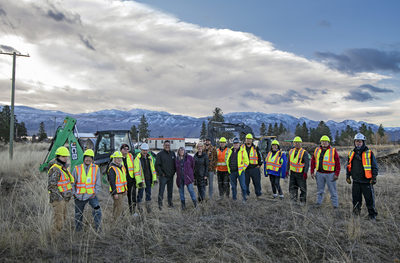
WorkSafeBC: Sun Safety at Work

WorkSafeBC reminding employers to keep both indoor and outdoor workers safe from heat stress
With last year’s heat dome, WorkSafeBC accepted 115 claims for heat stress; a 180 per cent increase over the previous three-year average.
Richmond, B.C. (July 25, 2022) — After a slow start to the summer weather, B.C. is now experiencing higher temperatures throughout the province. As temperatures rise, employers need to be aware of the risks to their workers — both indoor and outdoor — and implement measures to keep their workplaces safe.
Last year, B.C. was impacted by a record-setting heat dome with extreme temperatures throughout the province. As a result, WorkSafeBC accepted 115 claims from workers related to heat stress in 2021, a 180 per cent increase over the average 41 claims in the previous three years.
“We are hoping that the serious heat wave in 2021 has raised awareness about the dangers of working in high temperatures,” says Suzana Prpic, Senior Manager of Prevention Field Services at WorkSafeBC. “Whether you are working outdoors on a farm or construction site, or indoors in a restaurant kitchen, or in a factory—heat stress can cause serious injuries and even death.”
Prpic adds that indoor heat stress is an area of increasing concern. For example, in 2021, over one-third (35 per cent) of heat stress claims were for indoor workers.
“Workers in buildings or vehicles without adequate HVAC systems to mitigate sustained heat are increasingly at risk of heat-related injuries,” Prpic says.
Risk assessments are required
To prevent heat-stress injuries, WorkSafeBC requires employers to conduct heat stress assessments. As appropriate, employers must have a heat stress mitigation plan that provides education and training in recognizing the symptoms of heat-related injuries.
If not recognized and treated early, heat stress can lead to heat exhaustion and heat stroke. Symptoms of heat exhaustion include excess sweating, dizziness, fainting and muscle cramps. Symptoms of heat stroke include cessation of sweating, an increased breathing rate, confusion, seizures and even cardiac arrest.
WorkSafeBC encourages employers to engage their workers early in the process so they understand the risks, and participate in the assessment and control of those risks.
Below are some measures that employers and workers can do to prevent heat stress.
Prevention of Heat Stress: Employers
- Monitor heat conditions and require workers not to work alone.
- Ensure there is adequate first-aid coverage and emergency procedures are in place.
- Make physical modifications to facilities, equipment, processes to reduce exposure.
- Change work practices and policies to limit the risk.
- Determine appropriate work-rest cycles; when a worker feels ill it may be too late.
- Rotate work activities or use additional workers to reduce exposure.
- Establish cooling areas with shade and water.
Prevention of Heat Stress: Workers
- Drink plenty of water (one glass every 20 minutes).
- Wear light-coloured, loose-fitting clothing made of breathable fabric, such as cotton.
- Take rest breaks in a cool, well-ventilated area.
- Do hard physical work during the coolest parts of the day, before 11 a.m. and after 3 p.m.
- Know your personal risk factors, such as medications and any pre-existing conditions.
- Check the signs and symptoms for yourself and co-workers.
Key Facts
- Of the 115 accepted claims for heat stress in 2021, 74 were for outdoor workers, and 41 for indoor workers.
- In the previous three years (2018-2020), WorkSafeBC had a total of 122 accepted claims related to heat stress, or an average of 41 per year.
Many jobs require working in hot environments, both outdoors and indoors. Working in the heat and doing heavy physical work can affect the body's cooling system. If the body is unable to cool itself, a worker can experience heat stress. If heat stress is not recognized and treated in the early stages, more serious and even fatal conditions may quickly develop.
Workers who are required to work in hot conditions must be adequately prepared to deal with heat stress. Outdoor work activity often increases during the hot summer months, particularly in construction, roofing, forestry, forest fire fighting, and road construction. Indoor work activities in hot environments expose workers to heat year-round. These include working in pulp and paper manufacturing, industrial laundries, bakeries, steel manufacturing and fabricating, boiler rooms, and working near cement kilns. Workers exposed to hot environments must be trained to prevent heat stress and to recognize the early symptoms of heat stress in themselves and co-workers.
Heat stress can result in a range of problems from skin rashes and light-headedness to convulsions and unconsciousness. Early symptoms of heat stress - such as excessive fatigue, lethargy, irritability, lack of coordination, and altered judgment - can result in serious accidents. Unless treated promptly, these symptoms can rapidly develop into serious conditions, including convulsions and unconsciousness.
This booklet provides a basic overview of risk factors that increase the chances of suffering from heat stress, how to recognize and treat heat stress, and how to prevent heat stress. If you work in a hot environment, this booklet contains information essential to your health and safety.
Visit WorksafeBC Heat Stress

.png)
BC Government Releases Standardized Housing Designs

BCCA Industry Alert

WorkSafeBC Press Release

SICA Golf Tournament June 7th 2024

Unlocking Efficiency and Innovation: The Power of Building Information Modelling (BIM)

SICA Contractor's Breakfast 2024

BC Budget 2024

Revolutionizing Canada's Construction Industry: The Federal Prompt Payment Legislation

Young Builders Launch Party Wrap Up

CCO Workshop 2024

Membership Appreciation Evening Wrap Up 2023

CCA Hill Day 2023

EBT Flu Clinic Dates

SICA Golf Tournament September 2023

Long Term Members 2022/2023
.png)
Trap & Skeet 2023 Wrap-up

SICA Golf Tournament June 23rd 2023

Industry Awards of Excellence

BC Land Title & Survey Online Filing Process


Join the Virtual Webinar
.png)
The SICA September Golf Tournament was a hit!


Farewell to our Education Admin and Hello to our new SICA staff 2022

CCO Workshop 2022
.png)
MOTI and Infrastructure BC Seeking Interest From Qualified Firms For BC Highway Reinstatement Program RFQ
Prompt Payment Included in ‘Report on the Budget 2022 Consultation’

Regional Construction Associations Partner with BCCA Employee Benefit Trust to Provide Flu Shots for Industry

B.C. associations call on province to practice fair, transparent procurement

SICA announces 2020/2021 Industry Awards of Excellence Finalists

2021 Annual Report

Kelowna Crane Incident Legacy Education Fund

#Hangahighvisoutside

Brooklyn Site Crane Accident Statement

Construction Fast Lanes for COVID-19 Vaccine

Every Child Matters - Indigenous History Month
.jpeg)
Latest Construction Industry Statistics Reveal Strength Despite Pandemic Challenges
.jpeg)
BCCA Response to BC Budget 2021
.png)
CCA Responds to 2021 Federal Budget

Construction Month 2021

BuildForce Canada releases annual 10-year forecast

SICA training courses prove practical and meaningful to students

2021 Gold Seal Program Changes

Building Forward: Virtual Conference 2021

Nomination Period Opens for SICA’s Industry Awards of Excellence

Meet SICA's 2020 New Board Members

SICA's 2020 Annual Report

COVID-19 Update
Membership Benefits
As a Member you are a part of a collective voice, the SICA voice. Together, our voice is changing the construction community and helping your business grow through advocacy, networking events, affinity programs, direct business leads and more. Our voices promotes fairness, transparency and open communication in the construction industry. Join SICA to grow your business today and be a voice for our industry tomorrow.
JOIN NOW